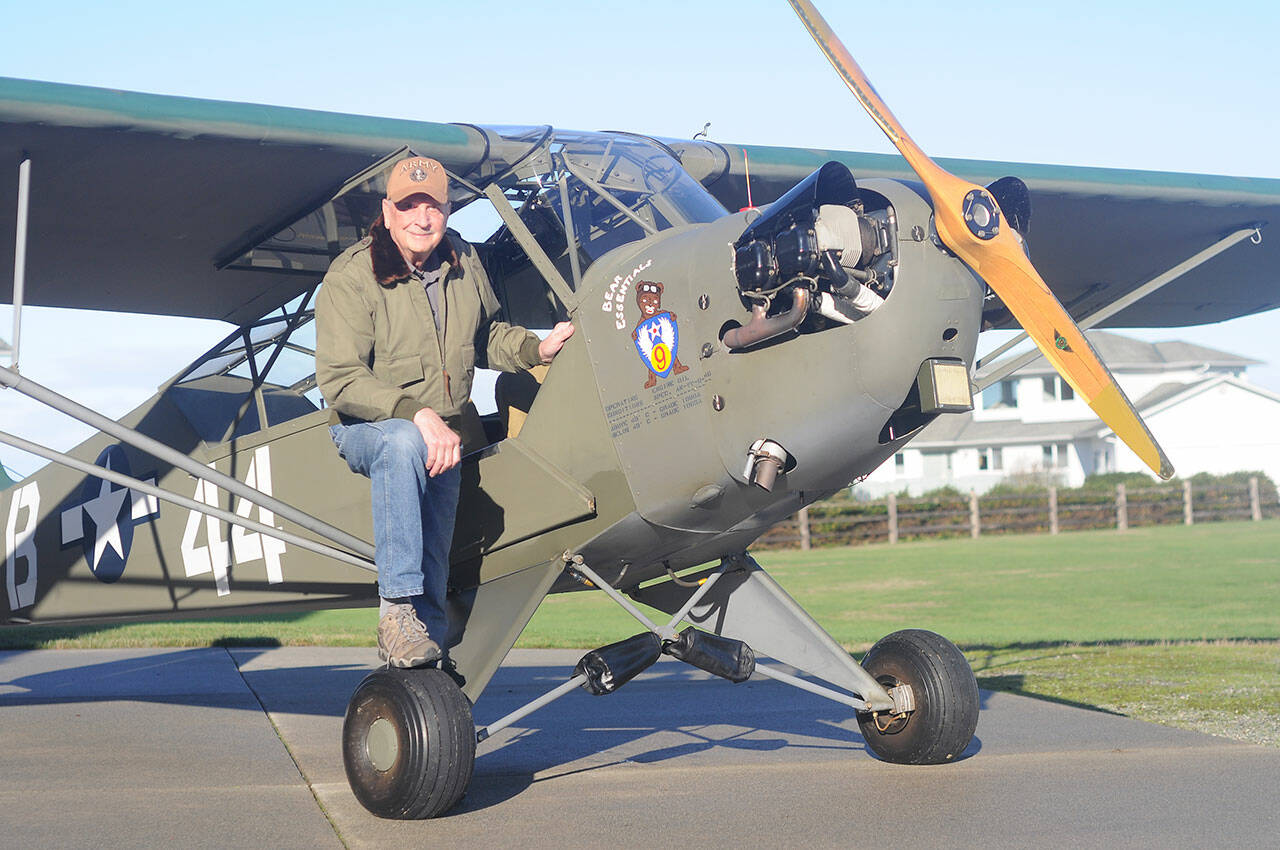SEQUIM — There’s a certain level of irony that one of the lightest and slowest planes used in World War II wound up being one of the most dangerous.
Sequim pilot David Woodcock wasn’t looking for any specific plane when he was thumbing through a trade publication and happened upon a 1944 Piper Cub L-4H, a lightweight liaison aircraft used to spot enemy targets and help soldiers set the range for their artillery during WWII.
“I wanted a plane with a documented combat history,” Woodcock said last week.
“I didn’t realize how rare (this one is).”
Woodcock seems to have exactly that in his hangar near the Dungeness Spit.
A native of Washington state and a longtime veteran of aerial photography, Woodcock — who served in the U.S. Air Force as a dentist in the late 1960s and early 1970s — has more than 50 years experience flying general aviation and experimental aircraft. He recently received the FAA Master Pilot Award.
His photo adventures have taken him from the Pacific Northwest to above the Arctic Circle in Canada, and from Alaska to the canyon lands of the American southwest.
So perhaps it was fitting that this type plane was so often used for aerial reconnaissance and photography as the military’s proverbial eyes in the sky.
According to Woodcock’s research, this particular L-4H was used in the 30th Infantry Division, Ninth Army’s efforts at the Battle of the Bulge, known as the bloodiest battle for U.S. forces in World War II.
Woodcock bought the plane in May 2020. Over a couple of months, structural issues within the wings and tail surfaces came to light.
The plane was disassembled and taken to the Port Townsend Aero Museum, where Mike Payne and Kevin Vogel spearheaded restoration efforts. Those were completed last December.
“When I’m done flying, that’s where it’s going to go,” Woodcock said.
About the L-4H
A plane developed from the civilian Piper Cub series, this L-4H joined a group of planes that had a variety of responsibilities, from spotting for artillery to dropping off medical supplies and transporting officers. They were piloted by both officers and qualified enlisted personnel.
Woodcock has photos of Dwight Eisenhower in one, plus another with Gen. George Patton in another liaison aircraft.
The nimble aircraft could take off and land on very small strips of land, and they sometimes flew directly off the deck of Landing Ship Tanks (LSTs).
Woodcock’s plane was built, accepted by the Army Air Force, then disassembled and crated in early April 1944. It was shipped to England in mid-May of that year and assigned to the Ninth Air Force.
These planes, he said, were often unboxed and re-assembled on beaches or roads starting in Africa and Italy and later Normandy; some were flown to France over the English Channel with an auxiliary fuel tank.
They were used extensively throughout the European Theater and, to a lesser degree, in the Pacific Theater.
A single battalion’s Piper Cub planes could, by spotting enemy positions, help deliver 50 tons of explosive steel, according to Woodcock’s research. They could direct artillery from the Army or Navy guns.
The plane, must have been maddening for enemies, Woodcock said. A relatively slow aircraft (its cruising speed is 75 mph, with a stalling speed of 37 mph), it gave anti-aircraft soldiers fits as they tried to adjust to its speed.
The plane doesn’t have fuel tanks in the wings, he said, so bullets often would pierce the fabric wings, and the plane would simply fly on.
An L-4H built on the same day as Woodcock’s aircraft, which was outfitted late in the war with three M9A1 bazookas under each wing, was credited with six German tank kills, earning Maj. Charles Carpenter’s aircraft the nickname “Rosie the Rocketer.”
“Rosie” now resides at the Hangar Annex of the American Heritage Museum in Massachusetts.
L-4Hs are two-seaters, with a spot for the pilot in front and another for an observer, who could face forward or backward, depending on the mission.
Many of the planes in Europe replaced some of the wing aluminum fairings with plexiglass just above the pilot’s head for better visibility to help evade German fighter aircraft.
The planes were used in all kinds of battles and conditions, and some were outfitted with skis. Pilots had to make repairs in the field, Woodcock said, and his restoration supervisors even found some evidence of welding in the fuselage structure that indicates it was repaired during its service.
After the war was over, the L-4Hs saw their stars and stripes painted over, and most were surplussed, Woodcock said.
However, a couple of hundred in Europe, like his, wound up getting shipped back to the United States. Woodock’s aircraft was purchased by a pilot for $300 and returned stateside in 1947.
The restoration puts Woodcock’s particular Piper Cub very close to its original state; colors and markings are period correct. Only a slight change in power — 90 horsepower rather than 65 — set it apart.
Michael Dashiell is the editor of the Sequim Gazette of the Olympic Peninsula News Group, which also is composed of other Sound Publishing newspapers Peninsula Daily News and Forks Forum. Reach him at editor@sequimgazette.com.

